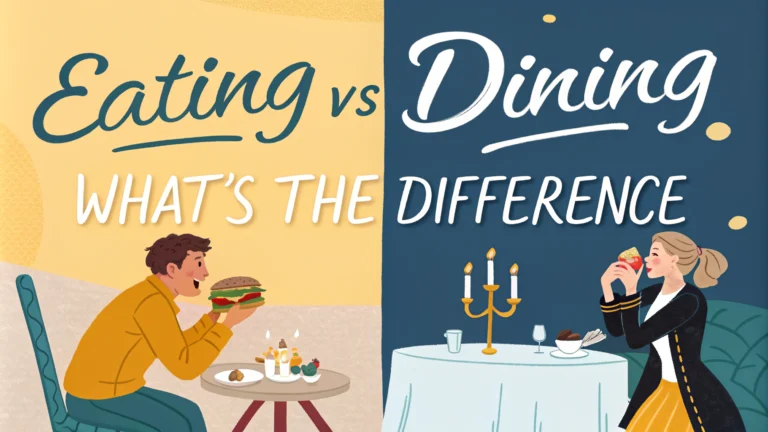The terms eating and dining represent distinct approaches to consuming food, each with its own set of social norms and cultural implications. While **eating** focuses on the basic act of food consumption, **dining** encompasses a broader experience involving atmosphere, presentation, and social interaction.
Learning to distinguish between these two practices helps navigate social situations and understand cultural expectations around food consumption. From casual family meals to formal business dinners, knowing when to apply appropriate dining etiquette makes a significant difference in social interactions.
Basic Definitions and Key Distinctions
- **Eating**: The fundamental act of consuming food for sustenance
- **Dining**: A social experience involving food, presentation, and etiquette
| Aspect | Eating | Dining |
|---|---|---|
| Purpose | Nourishment | Social interaction |
| Setting | Casual, informal | Structured, formal |
| Time investment | Quick, efficient | Extended, leisurely |
Essential Elements of Proper Dining Etiquette
- **Table manners** and proper utensil usage
- **Conversation skills** during meals
- **Pace** and timing of courses
- **Wine and beverage** protocol
Cultural Impact on Food Consumption Habits
Different cultures approach food consumption with unique customs and expectations. Understanding these differences helps avoid social mishaps and shows respect for diverse traditions.
- **Western formal dining** customs
- **Asian communal eating** practices
- **Mediterranean social dining** traditions
Key Differences Between Eating and Dining: A Social Guide
**Food consumption** takes different forms depending on the situation, setting and company. Understanding when to switch between casual eating and formal dining helps navigate social situations effectively and builds stronger relationships.
Setting the Right Expectations
- Recognize the **occasion type** and dress code
- Match your **behavior** to the environment
- Observe the **formality level** of others
Essential Dining Etiquette Rules
| Rule | Application |
|---|---|
| Napkin placement | On lap when seated, loosely folded |
| Utensil order | Work from outside in |
| Pace | Match the host or group |
Business and Professional Settings
- Focus on **conversation** over food
- Keep **phone use** minimal
- Wait for the **host** to begin eating
Cultural Considerations
Different cultures approach mealtimes with unique customs:
- **European** style: fork in left, knife in right
- **Asian** customs: communal dishes, chopstick etiquette
- **Middle Eastern** traditions: right hand for eating
Common Mistakes to Avoid
- Starting before everyone is served
- Talking with food in mouth
- Using wrong utensils for specific dishes
- Reaching across others
Modern Dining Trends
Recent shifts in dining culture include:
- **Casual fine dining** environments
- **Food sharing** plates
- **Digital etiquette** around photos and social media
Bringing Skills Together
Mastering the balance between casual eating and formal dining creates confidence in any social situation. Remember that etiquette exists to make others comfortable, not to create stress.
“Good manners are about making others feel comfortable, not about rigid rules.”
FAQs About Eating vs Dining
Q: What’s the main difference between eating and dining?
Eating is the basic act of consuming food for sustenance, while dining is a more formal, social experience that involves proper etiquette, table settings, and often multiple courses.
Q: What are the essential elements of formal dining etiquette?
Formal dining includes:
- Proper placement of utensils
- Following course sequences
- Using napkins correctly
- Engaging in table conversation
- Appropriate dress code
Q: Is fine dining always expensive?
No, fine dining isn’t always costly. The experience focuses on service quality, ambiance, and food presentation rather than just price.
Q: What makes casual eating different from casual dining?
Casual eating typically involves quick, informal meals, while casual dining includes table service and a more structured restaurant environment.
Q: How has fast-casual dining changed traditional eating habits?
Fast-casual establishments bridge the gap between fast food and casual dining, offering:
- Higher quality ingredients
- Counter service
- Moderate prices
- Faster service than traditional restaurants
Q: What are the social benefits of dining vs eating alone?
Social dining provides:
- Enhanced conversation opportunities
- Stronger relationships
- Cultural exchange
- Better eating pace
Q: How does dining etiquette vary across cultures?
Different cultures have distinct:
| Culture | Dining Characteristics |
|---|---|
| Western | Individual plates, multiple utensils |
| Asian | Shared dishes, chopsticks |
| Middle Eastern | Communal eating, hand dining |
Q: What are the essential components of a proper dining table setting?
A proper setting includes:
- Dinner plate
- Multiple utensils
- Wine and water glasses
- Bread plate
- Napkin
- Place card (formal settings)
Q: How has modern technology impacted dining vs eating habits?
Modern influences include:
- Food delivery apps
- Social media dining trends
- Online reservations
- Digital menus
Q: What role does ambiance play in dining vs eating?
Dining ambiance involves music, lighting, décor, and service style, while eating can occur in any environment without these considerations.



















